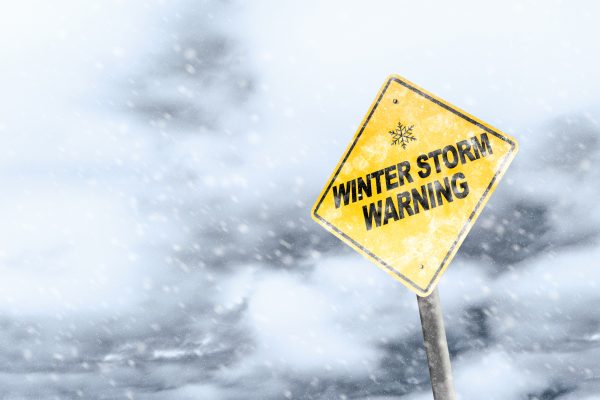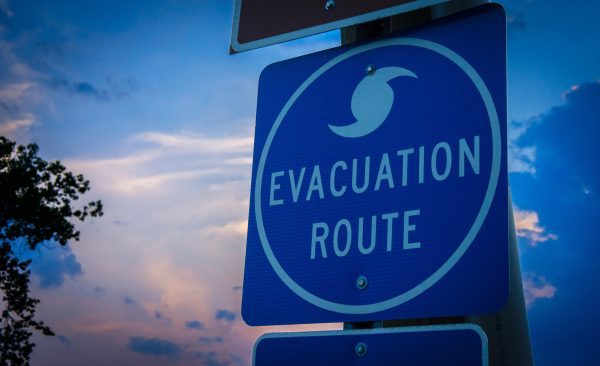Business & Community

Warning Signs for Severe Weather
Severe weather alerts and actions can help you prepare for natural disasters, such as tornadoes, hurricanes, flash floods, winter storms, and other severe weather threats.
Severe weather watches and warnings are passed along to the public via National Oceanic and Atmospheric Administration (NOAA) or the NOAA Weather Radio, mobile devices, and most radio and TV stations. Meteorologists are professionals trained to analyze patterns and natural indicators of weather conditions that may be threatening. They recommend the level of shelter necessary according to the type of alert. The different severe weather alerts that may be issued could make a difference in the level of damage or loss to individuals and communities because of a weather emergency.
Severe weather and tornadoes can develop quickly, so understanding the National Weather Service’s warning system is important.
Receiving Weather Alerts
An NOAA Weather Radio is a way to receive weather alerts. Every home needs one since these devices operate independently of cellular networks and are extremely reliable. This assures you will receive warnings even if your family is sleeping.
The second way is through your smartphone or mobile device. Every smartphone sold in the United States comes with the capability of receiving Wireless Emergency Alerts (WEA). When WEA is enabled, you will receive tornado warnings, flash flood warnings, hurricane warnings, and other critical messages from the National Weather Service and local authorities. Beyond WEA, it is recommended that you use a weather app of your choice that is designed to push watches and warnings to your phone. Most local TV stations offer free apps that serve this purpose. Evaluating cloud formations is a good skill to have, but do not rely on it to assess adverse weather conditions. It is best to act cautiously in the event of dangerous weather. Most importantly, be prepared to take shelter if advised. Think twice before putting yourself or your family members at risk by relying solely on an outdoor siren system. It is designed to alert people that are participating in outdoor activities. Be sure to follow all instructions provided by NOAA weather professionals.
Severe Weather Terminology
- Hazardous Weather Outlook: An announcement highlighting the potential for significant weather in a given area over the next seven days.
- Tornado Watch: A tornado watch means that conditions are favorable for severe thunderstorms and tornadoes in the watch area. Watch areas are large geographic areas, and a tornado watch is valid for 4 to 8 hours. Note: A particularly dangerous situation tornado watch means that a major (EF4 or EF5) tornado outbreak is possible.
- Tornado Warning: A tornado warning means a tornado has either been indicated by radar or sighted by trained personnel. Tornado warnings are currently issued to areas within a designated polygon-shaped area. Note: Warnings can be issued without a watch in effect. Also, a previous tornado warning may be reissued.
- Tornado Emergency: A tornado emergency is an upgraded tornado warning indicating that a violent tornado is likely to hit a heavily populated area.
- Severe Thunderstorm Watch: Severe thunderstorm watches mean that conditions are favorable for the development of severe thunderstorms within the watch area. Severe thunderstorm watches may include large damaging hail 1 inch in diameter or larger and/or damaging winds more than 58 mph. Isolated tornadoes may occur but are not expected. Watch areas involve large geographic areas, and a severe thunderstorm watch may be valid for 5 to 8 hours.
Note: A particularly dangerous situation thunderstorm watch is rare and is issued only when conditions are favorable for severe thunderstorms with winds greater than 90 mph. It also means that isolated tornadoes are possible but not expected.
- Severe Thunderstorm Warning: A severe thunderstorm warning is indicated by Doppler radar or sighted by trained spotters. It may contain large damaging hail 1 inch or larger and/or damaging winds in excess of 58 mph.
- Significant Weather Advisory: Significant weather advisories are issued when a strong thunderstorm is indicated by Doppler radar that may contain hail about 3/4 inch and/or strong winds near 50 mph. A significant weather advisory is issued on a county-by-county basis.
Winter Storms
 Winter storms are weather hazards associated with freezing or frozen precipitation such as rain, sleet, snow, and possibly strong winds.
Winter storms are weather hazards associated with freezing or frozen precipitation such as rain, sleet, snow, and possibly strong winds.
- Blizzard Warning: Blizzards are sustained winds or frequent gusts of 35 mph or greater with large amounts of falling or blowing snow. Visibility is reduced to ¼ mile or less for 3 hours or longer. There is no temperature restriction, but the wind creates a sub-zero wind chill.
- Blizzard Watch: A blizzard watch means that sustained winds or frequent gusts of 35 mph or greater with large amounts of falling or blowing snow are possible. Also, reduced visibility to ¼ mile or less for 3 hours or longer is possible within the next 48 hours.
- Winter Storm Warning: Hazardous conditions with sleet or heavy snow in excess of 7 inches, freezing rain, sleet, or strong winds that threaten life or property are likely, imminent, or occurring.
- Winter Storm Watch: A winter storm watch involves a significant accumulation of snow and/or freezing rain and/or sleet is possible in the next 48 hours.
- Winter Weather Advisory: Hazardous winter weather conditions are likely, imminent, or presently occurring over a specified area. Conditions include two or more of the following: snow, freezing rain or drizzle, sleet, and blowing snow. A warning may specify snow or blowing snow, so caution must be exercised.
Freezing Rain/Ice
- Ice Storm Warning: Indicates that heavy ice accumulation on trees and wires is imminent. The amount varies from ¼ to ½ inch of freezing rain.
- Freezing Rain Advisory: Indicates that a trace amount to ¼ inch of freezing rain is expected in the specified area.
- Freezing Drizzle Advisory: Indicates that a trace amount to ¼ inch of freezing drizzle is expected in the specified area.
- Freezing Fog Advisory: A widespread dense fog is in the area that reduces visibility to less than ¼ mile, occurring in a sub-zero environment and leaving thin glazing of ice.
Wind Chill
- Wind Chill Warning: Extreme, life-threatening wind chills (-20°F or lower) are imminent or presently occurring over a specified area.
- Wind Chill Advisory: Dangerous wind chills (about -5°F to -19°F) are imminent or presently occurring over a specified area.
- Wind Chill Watch: Life-threatening wind chills might occur over a specified area.
Floods
- River Flood Warning: Stream or river flooding is likely, imminent, or occurring. The warning is issued on a county-by-county basis and could be in effect for a couple of days or longer.
- Areal Flood Warning: General (areal) flooding of streets, low-lying areas, urban storm drains, creeks, and small streams is occurring or is imminent. The warning is issued for flooding that occurs more than 6 hours after excessive rainfall or when flooding is imminent or occurring but not rapid enough to call for a Flash Flood Warning. It is in effect for 6 to 12 hours and is issued on a polygonal basis.
- River Flood Advisory: Stream or river flooding is likely, imminent, or occurring. A river flood advisory is issued on a county-by-county basis and remains in effect for a couple of days or longer.
- Stream or river flooding is likely, imminent, or occurring. A river flood advisory is issued on a county-by-county basis and remains in effect for a couple of days or longer.
- Areal Flood Advisory: Minor general (areal) flooding of streets, low-lying areas, urban storm drains, creeks, and small streams is occurring or is imminent. The areal flood advisory is in effect for 3 to 6 hours and issued on a polygonal basis.
Other Hazards
- Urban & Small Stream Flood Advisory: Ponding of water on streets, low-lying areas, highways, underpasses, urban storm drains, and elevated creeks and small streams is imminent or occurring. This advisory usually occurs within 3 hours after excessive rainfall and is in effect for 3 to 4 hours when issued.
- Fire Weather Watch: Conditions are expected to become favorable for the spread of wildfires within the next 24 to 36 hours.
- Red Flag Warning: Conditions are favorable for the rapid spread of wildfires.
- Fire Warning: A fire is currently burning in the watch area, and evacuation is necessary.
- Heat Advisory: Heat index forecast to exceed locally defined criteria for 1 to 2 days, typically between 100 to 105°F and above 75°F at night.
- Freeze Warning: Widespread temperatures at or below 32° during the growing season.
- Hard Freeze Warning: Widespread temperatures at or below 28°F during the growing season.
- Frost Advisory: Widespread temperature forecast to be 33 to 36°F during the growing season on nights with light wind and clear skies.
- Dense Fog Advisory: Widespread or localized fog reducing visibility to ¼ mile or less.
- High Wind Watch: Issued when one of two conditions are possible; 1) sustained winds of 40 mph or more for an hour or longer or 2) wind gusts of 58 mph or higher for any length of time.
Other Preparedness Strategies
Develop a Family Emergency Plan

Know your emergency evacuation routes. Photo by Darwin Brandis, 2019.
Identify a place in your home that can be used for indoor shelter in case of emergency. Also, develop an evacuation plan in case you need to escape to safety. Your evacuation plan should always include a gathering place where everyone comes together for roll call. Avoid areas such as fire hydrants and utility poles. First responders may need access to these utilities.
Conduct practice drills at home so that you and your family are ready to act quickly when emergencies strike. You may be advised by local authorities to evacuate to a safer location. Plan ahead by mapping out at least two evacuation routes; noting that your first choice may be blocked or closed.
Disaster Kit and Bag
While natural disasters may be unpredictable, being prepared will help you and your loved ones to act decisively when such incidents occur. Therefore, it is important to have two different levels of preparedness kits in place:
- A “shelter in place” disaster kit in the event that you stay in your home or a shelter possibly without utilities or outside assistance for up to a week.
- A “go bag” in case you need to evacuate your home due to unsafe conditions. Be sure to take the “go bag” wherever you go.
Your “shelter in place” disaster kit should contain 1 gallon per person per day of drinking water and 2 gallons per person per day of water for sanitation (brushing teeth, washing dishes, and bathing). Don’t forget an extra gallon of water per day for any pets. You cannot rely on your home’s water supply to remain safe. For example, you may have to shut off your incoming water valve if you receive reports of broken water or sewage lines to stop contaminated water from entering your home.
Food Items
You will also need an assortment of shelf-stable foods that require little or no cooking and are protein-rich, such as soups, stews, protein bars, canned fruit, and chocolate for energy. Snack foods are good for quick consumption or an emotional lift, so include some crackers, cookies, and hard candies. If you have a cook stove of some kind, a hot pot of coffee, tea, or hot cocoa is always a plus. If your home was not destroyed, a cook stove is a great resource to use during emergencies.
The first thing to do during an emergency without electrical power is to conserve what is in your freezer and refrigerator for as long as possible. Pack items tightly together on the lowest possible shelves and open the door as few times as possible. Eat any seafood and sandwich meats from your freezer or refrigerator first, as these are the foods with the shortest shelf-life. If possible, add ice bags to your freezer to keep your food cold (Tschetter, 2018).
Remember to discard any perishables that were left at temperatures higher than 40°F for longer than four hours. You cannot tell if something is bad by taste or smell, and you cannot cook or heat to remove pathogens associated with spoilage. Also, remove all dirt from surfaces and cookware. Use dish soap and warm water when cleaning your cookware and dishes. Consider placing disposable utensils and plates in your “go bag” to reduce clean-up.
Other Essential Items
Remember that your “go bag” needs to be portable and able to hold all essential items you and your family will need. If you have many people in your family, consider multiple “go bags.” Be sure to keep cash (small bills) in your “go bag” since ATMs will not be accessible if the power is out. Keep in mind that businesses may be less likely to accept a check or credit card during emergencies. You will also need a week’s worth of medication in labeled bottles for all family members. Be sure to replace the medications in your “go bag” regularly and write down the prescription instructions since stress may cause you to forget the dosage and time at which medication may need to be given. Original bottles can be very useful during an evacuation if the need arises to contact your doctor for another prescription.
Emergency Contact List
In addition, be sure to include contact information for all your family members’ doctors. It is also important to have an emergency contact list complete with addresses and home, cell, and work numbers of local, in-town, and out-of-town persons. Remember, you or someone else will be contacting them during an emergency, which is an inconvenient time to search for phone numbers or addresses.
Stocking Your “Go-bag”
Your “go bag” should be kept where you plan to shelter in case of danger or an environmental threat. Items to place in your bag include:
- Non-perishable food items include a variety of canned goods that require little or no heating, bottled water, snacks such as crackers, dried fruit, chocolate, and hard candy; fluids such as canned or bottled fruit juices, canned or shelf-stable milk, and baby formula if needed. Also, when packing food, be sure to consider any special dietary restrictions of family members, such as those who may be diabetic or have a gluten intolerance.
- A camp stove including instructions
- A charged cell phone and a phone charger
- Plastic utensils, paper towels, and a hand can and bottle opener
- A battery-operated or crank-powered weather radio
- Quilts, blankets, or sleeping bags for all family members
- Disposable cloths, hand wipes, and diapers (if needed)
- Personal hygiene items, including soap, toothpaste, toothbrushes, disposable shavers, toilet paper, feminine care products, and deodorant
- Flashlight
- Glow sticks to use for low levels of light. Placing the stick in a clear container of water will refract the light, making the stick brighter and adding additional These are safer than a candle to use.
- Batteries in assorted sizes for all the battery-operated equipment
- Scissors, string, and duct tape
- A first-aid kit
- Medical supplies and prescription drugs for seniors and people with special needs including backups for individuals with glasses and hearing aid
- Disposable garbage bags
- A watch
- Tools to turn off utilities
- Clean, dry change of clothes for everyone in the family
- A deck of cards to help pass the time for adults and older children, and a toy or a favorite personal item for young children
- Important family documents such as copies of insurance policies, identification, and bank account records are in a waterproof portable container (Ready, 2021).
Summary
Hopefully, the day will never come when you and your family experience weather or manmade disasters or emergencies that leave you on your own, without power, and in need of your “shelter in place” disaster kit. However, with the information provided in this publication, you should be better prepared to meet your basic family needs should such an occasion arise. It is worth noting that different plans are needed for the various kinds of severe weather. What is acceptable for one type of severe weather may not be suitable for another.
Also, don’t forget to have your “go bag” ready and handy. It is a necessary supplement to your “shelter in place” kit while you are at home and what you have to carry with you if you need to evacuate at a moment’s notice. Always keep it available and stocked with personal items that you and your family may need so that you are prepared in the event of an emergency.
Additional Resources
- An Emergency Handbook: Preparation and Recovery
- Severe Weather Watches and Warning
- Dealing with Stress After a Storm
- Food and Water Safety When the Power Goes Out
References
National Oceanic and Atmospheric Administration. Severe Weather Preparedness: Warning Systems. https://www.weather.gov/unr/Warning_Systems.
National Oceanic and Atmospheric Administration. Watch/Warning/Advisory Definitions. https://www.weather.gov/lwx/WarningsDefined#Blizzard%20Warning.
Ready.Gov. Build a Kit. 2022. https://www.ready.gov/kit.
Tschetter, Emery. Food and Water Safety When the Power Goes Out. 2018. https://www.aces.edu/blog/topics/emergency-handbook-home-family/food-and-water-safety-when-the-power-goes-out/.
United States Department of Homeland Security. National Terrorism Advisory System. https://www.dhs.gov/national-terrorism-advisory-system.
United States Department of Homeland Security. 2021. National Terrorism Advisory System Bulletin. https://www.dhs.gov/sites/default/files/ntas/alerts/21_0127_ntas-bulletin.pdf.
 Revised by Karnita Garner, Ph.D., Alabama Extension Environmental Specialist, Alabama A&M University; and Tyler J. Mason, Ph.D., Director of Education and Visitor Experience, Birmingham Botanical Gardens. Originally by Jean Dwyer, retired Extension Communications Specialist, and Jannie Carter, Ph.D., retired Extension Assistant Director, Alabama A&M.
Revised by Karnita Garner, Ph.D., Alabama Extension Environmental Specialist, Alabama A&M University; and Tyler J. Mason, Ph.D., Director of Education and Visitor Experience, Birmingham Botanical Gardens. Originally by Jean Dwyer, retired Extension Communications Specialist, and Jannie Carter, Ph.D., retired Extension Assistant Director, Alabama A&M.
Revised August 2022, Emergency Preparedness: What Should You Do?, UNP-0033


